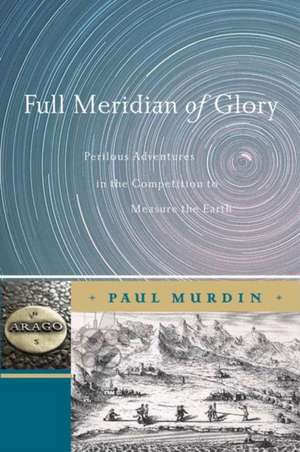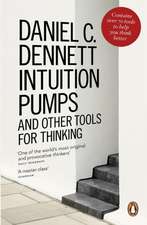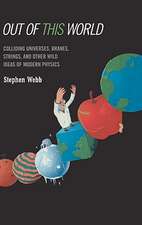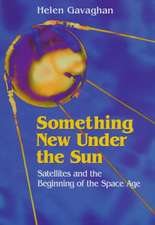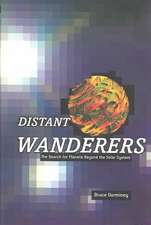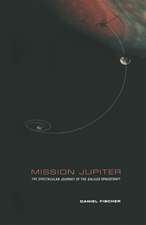Full Meridian of Glory: Perilous Adventures in the Competition to Measure the Earth
Autor Paul Murdinen Limba Engleză Hardback – 18 dec 2008
Dan Brown’s novel, The Da Vinci Code, was first published in 2003; its sales have reached 40 million worldwide. The book mixes a small spice of fact into a large dollop of fiction to create an entertaining novel of intrigue, adventure, romance, danger and conspiracy, which have been imaginatively worked together to cook up the successful bestseller.
Most interest in the book’s origins has centred on the sensational religious aspects. Dan Brown has written: ‘All of the art, architecture, secret rituals, secret societies, all of that is historical fact.’ This gives an air of authenticity to the book. Brown has, however, made up the religious doctrines, or based them on questionable accounts by others.
The locations of the actions of The Da Vinci Code are not, however, made up. The present book is the scientific story behind the scene of several of the book’s actions that take place on the axis of France that passes through Paris.
The Paris Meridian is the name of this location. It is the line running north-south through the astronomical observatory in Paris. One of the original intentions behind the founding of the Paris Observatory was to determine and measure this line. The French government financed the Paris Academy of Sciences to do so in the seventeenth to nineteenth centuries. It employed both astronomers – people who study and measure the stars – and geodesists – people who study and measure the Earth. This book is about what they did and why. It is a true story behind Dan Brown’s fiction.
This is the first English language presentation of this historical material. It is attractively written and it features the story of the community of scientists who created the Paris Meridian. They knew each other well – some were members of the same families, in one case of four generations. Like scientists everywhere they collaborated and formed alliances; they also split into warring factions and squabbled. They travelled to foreign countries, somehow transcending the national and political disputes, as scientists do now, their eyes fixed on ideas of accuracy, truth and objective, enduring values – save where the reception given to their own work is concerned, when some became blind to high ideals and descended into petty politics.
To establish the Paris Meridian, the scientists endured hardship, survived danger and gloried in amazing adventures during a time of turmoil in Europe, the French Revolution and the Napoleonic War between France and Spain. Some were accused of witchcraft. Some of their associates lost their heads on the guillotine. Some died of disease. Some won honour and fame. One became the Head of State in France, albeit for no more than a few weeks. Some found dangerous love in foreign countries. One scientist killed in self defence when attacked by a jealous lover, another was himself killed by a jealous lover, a third brought back a woman to France and then jilted her, whereupon she joined a convent.
The scientists worked on practical problems of interest to the government and to the people. They also worked on one of the important intellectual problems of the time, a problem of great interest to their fellow scientists all over the world, nothing less than the theory of universal gravitation. They succeeded in their intellectual work, while touching politics and the affairs of state. Their endeavours have left their marks on the landscape, in art and in literature.
| Toate formatele și edițiile | Preț | Express |
|---|---|---|
| Paperback (1) | 162.99 lei 38-44 zile | |
| Springer – 22 noi 2010 | 162.99 lei 38-44 zile | |
| Hardback (1) | 193.31 lei 3-5 săpt. | |
| Springer – 18 dec 2008 | 193.31 lei 3-5 săpt. |
Preț: 193.31 lei
Nou
Puncte Express: 290
Preț estimativ în valută:
36.99€ • 38.48$ • 30.54£
36.99€ • 38.48$ • 30.54£
Carte disponibilă
Livrare economică 24 martie-07 aprilie
Preluare comenzi: 021 569.72.76
Specificații
ISBN-13: 9780387755335
ISBN-10: 0387755330
Pagini: 190
Ilustrații: XVIII, 190 p. 39 illus., 31 illus. in color.
Dimensiuni: 155 x 235 x 18 mm
Greutate: 0.54 kg
Ediția:2009
Editura: Springer
Colecția Copernicus
Locul publicării:New York, NY, United States
ISBN-10: 0387755330
Pagini: 190
Ilustrații: XVIII, 190 p. 39 illus., 31 illus. in color.
Dimensiuni: 155 x 235 x 18 mm
Greutate: 0.54 kg
Ediția:2009
Editura: Springer
Colecția Copernicus
Locul publicării:New York, NY, United States
Public țintă
Popular/generalDescriere
The Paris Meridian is the name of the line running north-south through the astronomical observatory in Paris. One of the original intentions behind the founding of the Paris Observatory was to determine and measure this line. The French government financed the Paris Academy of Sciences to do so in the seventeenth to nineteenth centuries. It employed both astronomers – people who study and measure the stars – and geodesists – people who study and measure the Earth. This book is about what they did and why.
This is the first English language presentation of this historical material. It is attractively written and it features the story of the community of scientists who created the Paris Meridian. They knew each other well – some were members of the same families, in one case of four generations. Like scientists everywhere they collaborated and formed alliances; they also split into warring factions and squabbled. They travelled to foreign countries, somehow transcending the national and political disputes, as scientists do now, their eyes fixed on ideas of accuracy, truth and objective, all enduring values – yet when the reception given to their own work was concerned some became blind to high ideals and descended into petty politics.
To establish the Paris Meridian, the scientists endured hardship, survived danger, and gloried in amazing adventures during a time of turmoil in Europe consisting of the French Revolution and the Napoleonic War between France and Spain. Some were accused of witchcraft. Some of their associates lost their heads on the guillotine. Some died of disease. Some won honor and fame. One became the Head of State in France. Some found dangerous love in foreign countries. One scientist was killed in self defence when attacked by a jealous lover, another was himself killed by a jealous lover, a third brought back a woman to France and then jilted her, whereupon she joined a convent...
The scientists worked on practical problems of interest to the government and to the people. They also worked on one of the most important intellectual problems of the time, a problem of great interest to their fellow scientists all over the world- the theory of universal gravitation. They succeeded in their intellectual work while affecting politics and the affairs of state; their endeavours have left marks on the landscape, in art, and in literature still visible today.
This is the first English language presentation of this historical material. It is attractively written and it features the story of the community of scientists who created the Paris Meridian. They knew each other well – some were members of the same families, in one case of four generations. Like scientists everywhere they collaborated and formed alliances; they also split into warring factions and squabbled. They travelled to foreign countries, somehow transcending the national and political disputes, as scientists do now, their eyes fixed on ideas of accuracy, truth and objective, all enduring values – yet when the reception given to their own work was concerned some became blind to high ideals and descended into petty politics.
To establish the Paris Meridian, the scientists endured hardship, survived danger, and gloried in amazing adventures during a time of turmoil in Europe consisting of the French Revolution and the Napoleonic War between France and Spain. Some were accused of witchcraft. Some of their associates lost their heads on the guillotine. Some died of disease. Some won honor and fame. One became the Head of State in France. Some found dangerous love in foreign countries. One scientist was killed in self defence when attacked by a jealous lover, another was himself killed by a jealous lover, a third brought back a woman to France and then jilted her, whereupon she joined a convent...
The scientists worked on practical problems of interest to the government and to the people. They also worked on one of the most important intellectual problems of the time, a problem of great interest to their fellow scientists all over the world- the theory of universal gravitation. They succeeded in their intellectual work while affecting politics and the affairs of state; their endeavours have left marks on the landscape, in art, and in literature still visible today.
Cuprins
The Incroyable Pique-nique and the Méridienne Verte.- The Size of France.- Shape of the Earth.- The Meridian and the Sun.- The Revolution and the Meter.- The Paris Meridian in the Napoleonic Wars.- Past its Prime.- The Greenwich and Paris Meridians in the Space Age.- On the Trail of The Da Vinci Code.- Walking the Line: the Arago Memorial.
Recenzii
From the reviews:
"This book was clearly a labor of love; Murdin has brought his passion for astronomy and its history to a topic which on the surface appears quite apart from this activity. … The publisher has supported Murdin’s effort with a physically appealing, aesthetic work, on high quality paper, complete with lovely diagrams and photographs. … I recommend it for the general reader. … For the motivated reader, the effort will be well rewarded with a picaresque journey through a relatively unknown section of scientific history." (Library Thing, May, 2009)
"The immediate impression of the book is quality … . Murdin starts the journey with a very brief introduction to the relationship between mapping latitude and longitude and the movement of astronomical bodies such as Jupiter. … Throughout the entire book, Murdin skillfully balances the technical details mapping techniques and instruments … . Overall, this book is a handsome, quality, very readable volume that deserves a prominent position in any history of science and engineering." (Library Thing, April, 2009)
"British astronomer Murdin … carefully examines the history of the Paris meridian in a work designed to highlight the adventures connected with the performance of what many might see as rather tedious research. … In a report that stretches over centuries, Murdin is careful to define terms, introduce the important characters, and include many nice illustrations. … Summing Up: Recommended. General readers." (M.-K. Hemenway, Choice, Vol. 46 (10), June, 2009)
“This modestly priced volume takes us on three journeys. The first is across the globe … to discover the true figure of the Earth, and all this amid the turmoil surrounding the French Revolution. … The second journey is through time, in which the role of the meridian is discussed … . And finally, we are taken on a journey across Paris, along the meridian … provided that the book can act as a guide for those wishing to follow the trail for themselves.” (David Stickland, The Observatory, Vol. 129 (1213), December, 2009)
"This book was clearly a labor of love; Murdin has brought his passion for astronomy and its history to a topic which on the surface appears quite apart from this activity. … The publisher has supported Murdin’s effort with a physically appealing, aesthetic work, on high quality paper, complete with lovely diagrams and photographs. … I recommend it for the general reader. … For the motivated reader, the effort will be well rewarded with a picaresque journey through a relatively unknown section of scientific history." (Library Thing, May, 2009)
"The immediate impression of the book is quality … . Murdin starts the journey with a very brief introduction to the relationship between mapping latitude and longitude and the movement of astronomical bodies such as Jupiter. … Throughout the entire book, Murdin skillfully balances the technical details mapping techniques and instruments … . Overall, this book is a handsome, quality, very readable volume that deserves a prominent position in any history of science and engineering." (Library Thing, April, 2009)
"British astronomer Murdin … carefully examines the history of the Paris meridian in a work designed to highlight the adventures connected with the performance of what many might see as rather tedious research. … In a report that stretches over centuries, Murdin is careful to define terms, introduce the important characters, and include many nice illustrations. … Summing Up: Recommended. General readers." (M.-K. Hemenway, Choice, Vol. 46 (10), June, 2009)
“This modestly priced volume takes us on three journeys. The first is across the globe … to discover the true figure of the Earth, and all this amid the turmoil surrounding the French Revolution. … The second journey is through time, in which the role of the meridian is discussed … . And finally, we are taken on a journey across Paris, along the meridian … provided that the book can act as a guide for those wishing to follow the trail for themselves.” (David Stickland, The Observatory, Vol. 129 (1213), December, 2009)
Notă biografică
Paul Murdin is the Treasurer of the Royal Astronomical Society and Professor of Astronomy at Cambridge University
Textul de pe ultima copertă
The Paris Meridian is the name of the line running north-south through the astronomical observatory in Paris. One of the original intentions behind the founding of the Paris Observatory was to determine and measure this line. To that end, the French government financed the Paris Academy of Sciences to do so in the seventeenth to nineteenth centuries employing both astronomers – people who study and measure the stars – and geodesists – people who study and measure the Earth. This book is about what they did and why.
Full Meridian of Glory is the first English language presentation of this historical material in its entirety. It is an attractively written story of the scientists who created the Paris Meridian. They collaborated and worked together in alliances, like scientists everywhere; they also split into warring factions. They transcended national and political disputes, as scientists do now, their eyes fixed on ideals of accuracy, truth and objectivity. Yet also when their work served national interests they were sometimes less than neutral, and if their work was questioned they sometimes blindly descended into petty politics.
This book tells the story of the adventures in France, in Spain, in Lapland and in Ecuador of the scientists who worked through revolution, war, rebellion, piracy, fire, shipwreck, blockade, snow, tropical heat, kidnapping, murder and turbulent love affairs to pursue a problem of map making. They turned that practical problem into a crucial scientific test of one of the most important intellectual problems of their time – Newton’s theory of universal gravitation. Their work changed their own lives, affected the course of science and politics, and left its mark on the landscape, the art and the literature of history and in our own age.
Full Meridian of Glory is the first English language presentation of this historical material in its entirety. It is an attractively written story of the scientists who created the Paris Meridian. They collaborated and worked together in alliances, like scientists everywhere; they also split into warring factions. They transcended national and political disputes, as scientists do now, their eyes fixed on ideals of accuracy, truth and objectivity. Yet also when their work served national interests they were sometimes less than neutral, and if their work was questioned they sometimes blindly descended into petty politics.
This book tells the story of the adventures in France, in Spain, in Lapland and in Ecuador of the scientists who worked through revolution, war, rebellion, piracy, fire, shipwreck, blockade, snow, tropical heat, kidnapping, murder and turbulent love affairs to pursue a problem of map making. They turned that practical problem into a crucial scientific test of one of the most important intellectual problems of their time – Newton’s theory of universal gravitation. Their work changed their own lives, affected the course of science and politics, and left its mark on the landscape, the art and the literature of history and in our own age.
Caracteristici
An exciting, true account of the adventures of the scientists who carried out a major scientific enterprise
The first English language account of this story
Features many of the locations and memorials in France of the incidents that happened during the measurements made by the scientists and can be used as a travel guide
The first English language account of this story
Features many of the locations and memorials in France of the incidents that happened during the measurements made by the scientists and can be used as a travel guide
